
The beautiful Luxman R-1500 receiver was introduced in 1975 and on the market until about 1979. It was Lux’s most powerful receiver at the time and the top-of-the-line in their R series of stereos that included the R-600 and R-800. It produces 75 watts per channel into 8 ohms. It has an interesting mix of knobs, switches and push buttons on the front panel and two large meters to the left of the dial scale.
What does the R-1500 sound like? Well, some have claimed that it sounds like a Yamaha Natural sound receiver but with better bottom end bass response.

The gold / orange backlighting of the Signal strength and FM tuning meters contrasted with the soft white backlighting of the dial scale really adds to the sophisticated look of the R-1500. The meters are very large compared to other receivers of the time.
There are a few different versions of the R-1500 including the R-1500E and the R-1500S but they are essentially identical both in looks and performance. I believe the E and S versions were sold in Europe. In fact, I’m not sure how many R-1500’s were sold in the US. Probably not many. The S versions I’ve seen are 220 volt and the E version 120 volt. But, according to the manual, the E version had a voltage selector switch which I have not seen. The E model seems to be the most common.
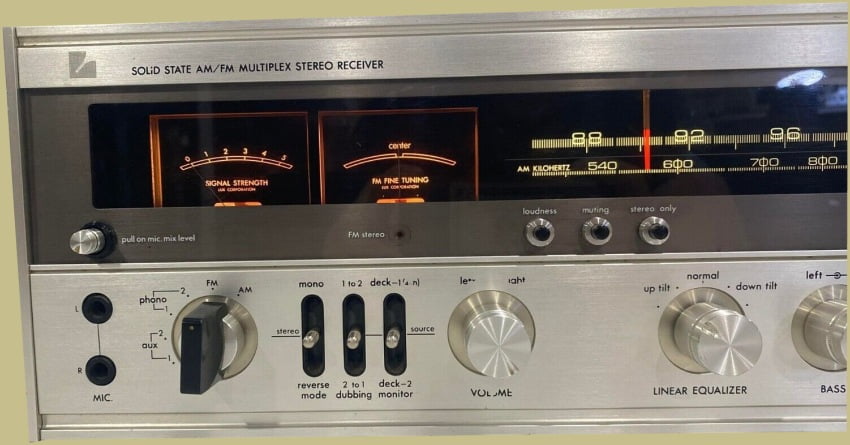
One unique feature of Luxman’s R-1500 is the Linear Equalizer. Sometimes, the way we listen to music can be affected by the room we’re in and its acoustics. Regular tone controls, which adjust the bass and treble, may not be enough to fix these issues because they have a wide range and their adjustments can overlap.
That’s where the Linear Equalizer control on the R-1500 comes in. It’s designed to provide a different kind of tonal adjustment that works alongside regular tone controls. When the Linear Equalizer control is in the middle position, the sound is flat with no changes. But when you switch it to the “up-tilt” positions, the sound curve shifts around a fixed point at 1 KHz. This means that the treble increases while the bass decreases. On the other hand, selecting one of the “down-tilt” positions makes the sound curve shift in the opposite direction. This decreases the treble while increasing the bass.
The amount of change for each setting was carefully predetermined. The overall sound curve remains linear from 50Hz to above 10KHz, which is different from regular tone controls that can introduce a curved response. Specifically, when you turn the control to the first “up-tilt” position, it will decrease the bass by 1.5dB and increase the treble by 1.5dB at 100Hz and 10KHz, respectively. Choosing the second “up-tilt” position will result in a 3dB change at the same frequencies. Similarly, selecting the first “down-tilt” position decreases the treble by 1.5dB and increases the bass by 1.5dB, while the second “down-tilt” position provides a 3dB change (boost at 100Hz and cut at 10KHz).
By using both the Linear Equalizer and regular tone controls together, you can achieve a greater range of tonal adjustments compared to most other tone control setups. This extra circuitry doesn’t introduce any additional distortion to the sound either, maintaining its clarity at any of the settings.

Specifications:
- Tuning range: FM, MW
- Power output: 75 watts per channel into 8Ω (stereo)
- Frequency response: 15Hz to 35kHz
- Total harmonic distortion: 0.05%
- Input sensitivity: 2mV (mic), 2.7mV (MM), 150mV (DIN), 150mV (line)
- Signal to noise ratio: 60dB (mic), 66dB (MM), 90dB (DIN), 90dB (line)
- Output: 150mV (line), 30mV (DIN)
- Dimensions: 20.5″ x 6.3″ x 16.5″ (520 x 420 x 152mm)
- Weight: 43.33 lbs (19.5kg)
- Head-phone Jack
- Mode Selector (stereo-stereo rev-mono)
- Speaker selector (A, B, C, A+8, A+C,OFF)
- Dual monitor circuit (useful for tape to tape dubbing)
- Protection circuit for amp & speaker
- Mic Mixing
- Stereo only switch
- AM noise filter
From the manual:
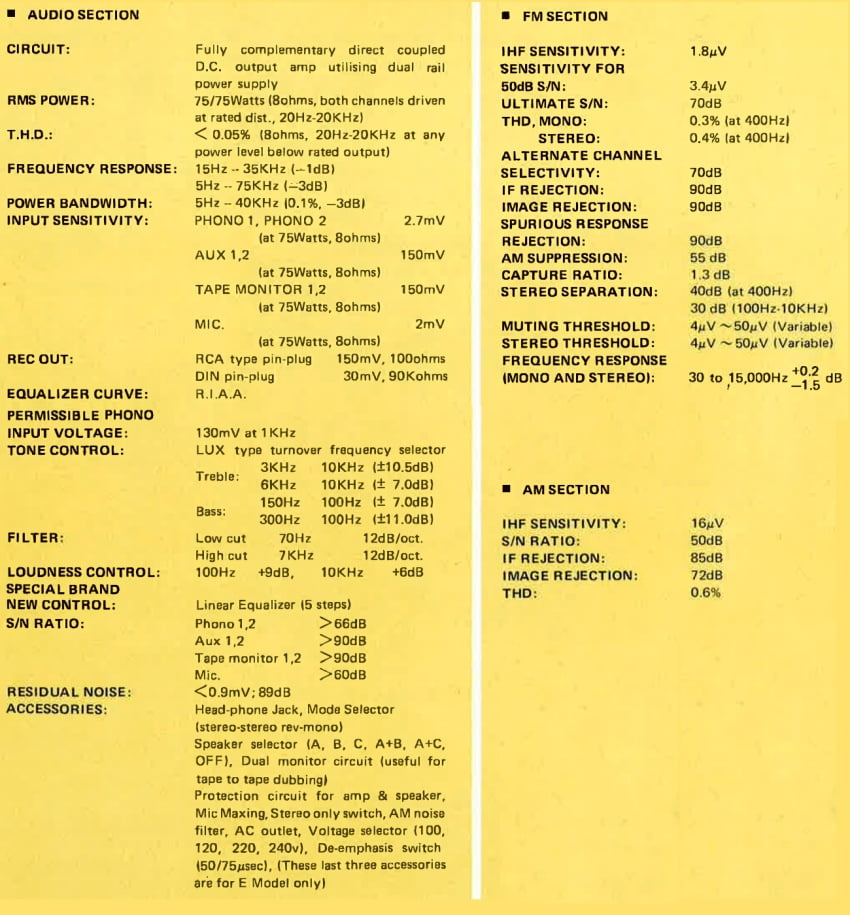
The case on the R-1500 is an elegant and stylish rosewood. I believe maple was an option as well. One issue you do see with the R-1500 is that the silk screened lettering on the faceplate can wear off. Be careful if you clean the faceplate that you don’t remove the lettering accidentally.

For the R-1500, Lux used a fully complementary, direct coupled, D.C. output amp utilizing a dual rail power supply. As you can see below the inside of the R-1500 is very well organized. The layout is clean and efficient. In fact, the output boards are two separate modules mounted at the back of the receiver and attached to their own heat sinks with venting in the wood case just above them. In general the R-1500 is very easy to work on.
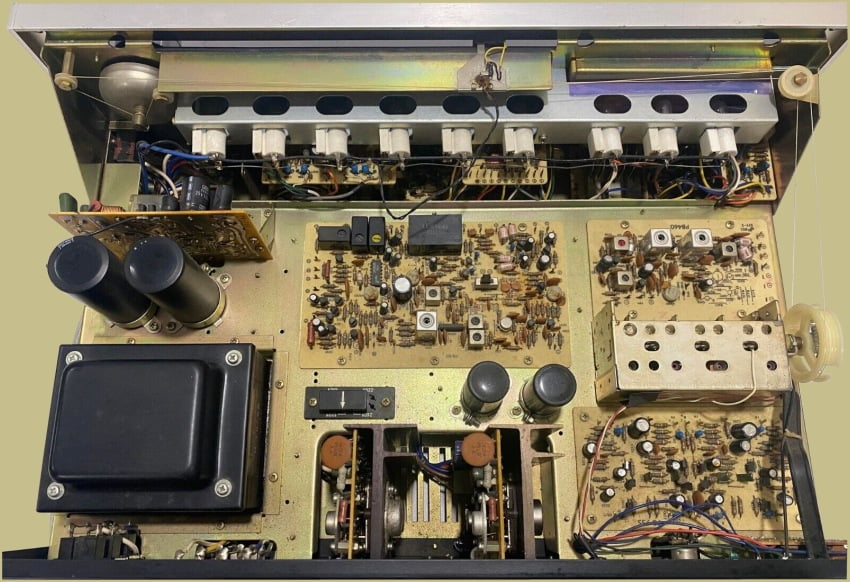
The FM tuning section of the R-1500 is very good. Karl Breh of HiFi Stereophony said at the time, “All of the transmission data we measure, which are essential for good FM or stereo reception, deserve the designation well or very well“.
The back of the Luxman R-1500 sports connections for 3 sets of speakers, to turntables, two auxiliary devices, tape and mic. These days the extra phono and aux connections can come in handy.

The Luxman R-1500 is a very desirable receiver. The 75 watts of power per channel is plenty for most use cases. The FM tuner can pick up stations far and wide with clarity. The plentiful connections allow you to put together an extensive audio setup. The build quality is excellent and it doesn’t really have any common engineering weaknesses. Plus it looks great. They’re not easy to find, especially in the U.S., but if you do find one it’s probably worth getting.
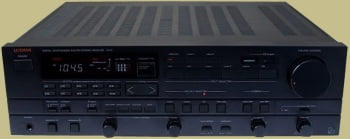
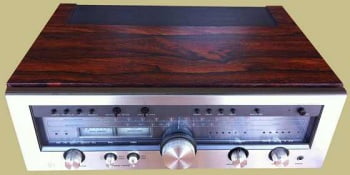
I had an R-1500E when I lived in the UK, and can confirm that it was 240v only with no external voltage selector.
These had internal voltage selection. It is also shown in the picture of the internal chassis (#7) just to the right of the transformer. Little black puck with a white arrow. 100v, 117v, 220v, 240v. I have restored many of these and they sound spectacular.